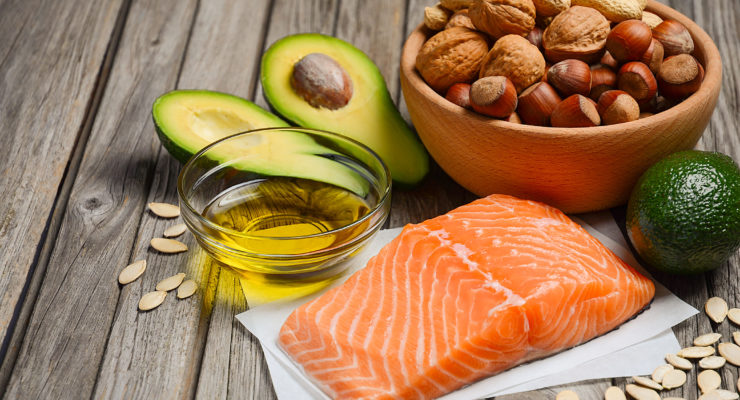13 Mighty Micronutrients You Need in Your Diet & How to Get Them
Article posted in: Diet & Nutrition
Protein, carbohydrates and fats get all of the attention when we talk about healthy eating. That’s because they are the big building blocks of your body, and every day they provide the energy it needs to keep working. But those “macronutrients” depend on the support of a powerful group of “micronutrients”—the vitamins and minerals that enable your body to produce critical enzymes and hormones that break down your food into components you can absorb and use. Though you need only minute amounts of the micronutrients, they are essential to reaching and sustaining your healthy weight.
Learning exactly how much of each vitamin and mineral you need to consume can be a little confusing. For the 13 most critical micronutrients, there is a Dietary Reference Intake (DRI)—the amount recommended by the National Academies of Science. These amounts are presented in different formats because the most current research about the nutrients varies. These are the four common ways you’ll see nutrient recommendations presented:
- Estimated Average Requirement (EAR) is an estimate of the amount that will meet the needs of half of the healthy population.
- Recommended Daily Allowances (RDA) are set at levels that are sufficient to meet the nutritional requirements of up to 98 percent of healthy people.
- Adequate Intake (AI), used in cases of nutrients when an RDA has not been determined, is based simply on the observed consumption of healthy people.
- Tolerable Upper Intake Level (UL) denotes the highest level of daily consumption that is likely to pose no risk of adverse health effects.
No matter what the recommendation, the best way to ensure you are fully stocked with the micronutrients you need is to eat a healthy, well-balanced diet, like your Nutrisystem plan.
Here’s the roster of the 13 essential micronutrients, how much you need, their most important contributions to your health and the best food sources for each of them:
1. Vitamin D


How much you need each day: 600 IU for adults, 800 IU after age 70
Why you need it: Vitamin D is necessary for you to absorb calcium from your food, so it plays a vital role in building strong bones and maintaining an active metabolism. Vitamin D aids in muscle movement and in transmitting messages to and from the brain, too.
Where to get it: Vitamin D is not naturally abundant in many foods, though you can get small amounts from fish such as salmon, tuna and mackerel, as well as beef liver and egg yolks. Milk sold in the United States is typically fortified with added vitamin D, as are many brands of orange juice and breakfast cereal. Your body will make its own supply of vitamin D when your skin is exposed to sunlight—for most people, about 10 minutes a day is enough.
*Information according to The U.S. Department of Health & Human Services
2. Vitamin B12


How much you need each day: 2.4 micrograms for adults, 2.8 mcg for breastfeeding women
Why you need it: Vitamin B12 is a key component of DNA, the genetic code in every cell. It helps maintain both blood cells and nerve cells. A sufficient supply of vitamin B12 prevents megaloblastic anemia, which can leave you feeling chronically fatigued and weak.
How to get it: Clams and beef liver are the richest food sources of vitamin B12, but all kinds of fish and meat, as well as poultry and other dairy products provide you with a healthy dose. Some breakfast cereals come fortified with the nutrient.
*Information according to The U.S. Department of Health & Human Services and Academy of Nutrition and Dietetics
3. Calcium


How much you need each day: 1000 milligrams for women under 50, men over 50 and breastfeeding women; and 1200 mg for women over 50
Why you need it: Your bones and teeth depend on calcium to stay strong and healthy. The mineral also helps move blood throughout your body and plays a role in producing and releasing hormones and enzymes that impact nearly every bodily function.
How to get it: Dairy products such as milk, cheese and yogurt can supply your daily need for calcium, one of the most vital micronutrients. Fish with soft bones you eat, such as canned sardines, kale and broccoli offer you smaller but still substantial amounts of calcium.
*Information according to The U.S. Department of Health & Human Services
4. Vitamin B1


How much you need each day: 1.1 milligrams for adult women and 1.2 mg for men
Why you need it: Also known as thiamin, this nutrient helps break down and convert the carbohydrates you eat into energy. Your nervous system relies on it for enzymes that keep it functioning smoothly.
How to get it: Whole grains and foods made with them (bread, cereal and pasta) are rich sources of thiamin, as are legumes (such as black beans and chickpeas), seeds and nuts. Pork and fish also supply you with vitamin B1, making it one of the most easily-attainable micronutrients.
*Information according to The U.S. Department of Health & Human Services and Academy of Nutrition and Dietetics
5. Vitamin C


How much you need each day: 75 milligrams for adult women, 90 mg for adult men and 120 mg for breastfeeding women.
Why you need it: As you may know, vitamin C ensures that your immune system is fully armed to protect you from colds and other illnesses, making it one of the most important micronutrients. An antioxidant, vitamin C neutralizes “free radicals,” which are damaging by-products of the process of converting food into energy. Sometimes listed on food labels as ascorbic acid, vitamin C is vital to your body’s production of collagen, the protein that replenishes your skin and heals wounds.
How to get it: You’ve probably heard that citrus fruits like oranges and grapefruits are loaded with vitamin C—which is true—but so are lots of other kinds of produce, especially bell peppers, strawberries, tomatoes and kiwifruit. Be aware that high temperatures cause vitamin C to dissipate from food, so eat plenty of these fresh fruits and vegetables raw.
*Information according to The U.S. Department of Health & Human Services and Academy of Nutrition and Dietetics
6. Iron


How much you need each day: 18 milligrams for adult women, 8 mg for men and women older than 50, and 9 mg for breastfeeding women
Why you need it: This mineral is essential for making hemoglobin, the protein in red blood cells that carries oxygen to all parts of your body. Iron also is key to the maintenance of connective tissues between your skeleton and muscles.
How to get it: Lean meats are the most reliable source of iron, but you also get some from seafood and poultry. Beans, including lentils and peas, along with nuts and raisins are plant-based sources of iron, but they have a form of iron that is not as potent as the type that is found in meats and fish.
*Information according to The U.S. Department of Health & Human Services and Academy of Nutrition and Dietetics
7. Vitamin B2


How much you need each day: 1.1 milligrams for adult women, 1.3 mg for adult men and 1.6 mg for breastfeeding women
Why you need it: Like other nutrients in the vitamin B complex, riboflavin (as B2 is also known) is active in digesting food and transforming it into energy. Riboflavin supports the growth, development, and function of all the cells in our body.
How to get it: Eggs, lean meats, and low-fat milk supply substantial amounts of B2. You also get some from broccoli, spinach and other green vegetables. Bread and breakfast cereals often come fortified with riboflavin.
*Information according to The U.S. Department of Health & Human Services and Academy of Nutrition and Diatetics
8. Vitamin B6


How much you need each day: 1.3 mg for adults, 1.5 mg for women > 50 and 1.7 mg for men > 50
Why you need it: Your metabolism relies on more than 100 enzymes created with vitamin B6 to break down food into energy. The nutrient also is essential for a baby’s healthy brain development before birth.
How to get it: Organ meats, poultry and fish supply much of your vitamin B6 needs. Potatoes and other starchy vegetables are also good sources.
*Information according to The U.S. Department of Health & Human Services and Academy of Nutrition and Dietetics
9. Vitamin E


How much you need each day: 15 milligrams for adults and 19 mg for breastfeeding women
Why you need it: Vitamin E is a potent antioxidant that helps knock out free radicals, damaging compounds that can cause a variety of illnesses. Vitamin E contributes to keeping blood vessels open and preventing unhealthy clotting.
How to get it: Using a little vegetable oil, particularly sunflower and safflower oils, furnishes the vitamin E you need. Nuts, seeds and green vegetables offer you a modest amount, too.
*Information according to The U.S. Department of Health & Human Services and Academy of Nutrition and Dietetics
10. Vitamin A


How much you need each day: 5,000 IU for adult women and adult men (this is based on a Daily Value, which is slightly different than DRIs.)
Why you need it: A healthy supply of vitamin A protects your vision and bolsters your immune and reproductive systems. Your heart, lungs and kidneys rely on vitamin A to perform their vital functions.
How to get it: Your body produces vitamin A from two different compounds in food. Preformed vitamin A is most abundant in beef liver and other organ meats, but hefty amounts also come from poultry, fish such as salmon, and dairy products. You get the most pro-vitamin A from broccoli and other dark green vegetables, along with orange and yellow foods such as carrots, squash, cantaloupe and apricots.
*Information according to The U.S. Department of Health & Human Services and Oregon State University
11. Zinc


How much you need each day: 8 milligrams for adult women, 11 mg for adult men and 12 mg for breastfeeding women
Why you need it: Your body uses this mineral to make proteins and DNA in every cell. It also supports your immune system’s work at fighting off destructive bacteria and viruses, and it helps wounds heal. During pregnancy and infancy, zinc is essential to healthy growth and development.
How to get it: Oysters are the best food source of zinc, but it’s abundant in other shellfish such as crabs and lobster, too. Red meat and poultry also contain small amounts of zinc, as do beans, nuts and whole grains.
*Information according to The U.S. Department of Health & Human Services
12. Magnesium


How much you need each day: 310 milligrams for women ages 19-30, 320 mg for women > 30, 400 mg for men 19-30, and 420 mg for men > 30
Why you need it: Magnesium is an important component of more than 300 enzymes in your body, which activate nerves and muscles, regulate blood pressure and blood sugar levels, and steadily generate new cells.
How to get it: Dark leafy green vegetables, such as spinach and kale are the best sources of magnesium, which is one of the most important micronutrients. All kinds of beans, nuts, seeds, whole grains and dairy products also have the mineral.
*Information according to The U.S. Department of Health & Human Services and Academy of Nutrition and Dietetics
13. Folate


How much do you need: 400 micrograms for adults and 500 mcg for breastfeeding women
Why you need it: Folate—another of the B-complex vitamins—is essential for producing DNA and healthy new cells. It’s especially important during pregnancy, when a sufficient supply dramatically reduces the risk of birth defects.
How to get it: Non-starchy vegetables, particularly asparagus, Brussels sprouts and dark leafy greens, provide all the folate you need. You also get some from nuts and beans and whole grainsmaking folate one of the most easily attainable micronutrients.
*Information according to The U.S. Department of Health & Human Services and Academy of Nutrition and Dietetics














